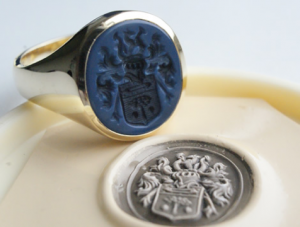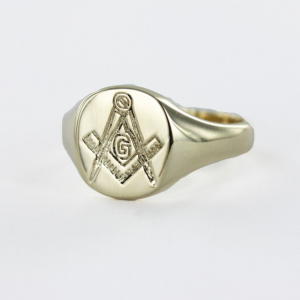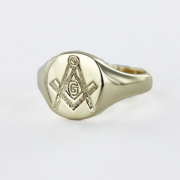
Worn with class or ostentatious? And is it real or fake?
For some people just an accessory, for others very meaningful. How come?
Let's take a closer look at what this signet ring actually is.
Traditionally, the signet ring was or is worn on the little finger of the non-dominant hand. For most people, this is the left hand. Businessmen, politicians and nobility used it to print their 'seal' on important documents, or to seal them. Hot wax would be dripped on the document, and the ring would be sealed by pushing an imprint of the coat of arms into it. Clearly recognisable as authentic to everyone, especially in earlier times when the majority could not even read. This type of ring soon became a traditional symbol of family solidarity. The use of seals can be dated back to the Mesopotamians, and so via the Egyptians, who incorporated it into a ring, to the Romans. The signet ring has therefore existed much longer than coats of arms or the emergence of heraldry.
With the rise of the bourgeoisie, it quickly gained popularity. If the middle classes did not have their own coat of arms, they used it anyway, either blank or with
initials, in order to appear sophisticated. If you were very wealthy in the 18th century, a beautiful stone could also be incorporated. The most popular stones were rubies, amethysts, blood stones and cornelians. They were mainly forged in gold, and from the 19th century platinum also became popular.

- The Pope has worn a signet ring called 'The Ring of the Fisherman' ('Piscatory Ring') since about 1265, with an effigy engraving of Saint Peter.
- When the Pope dies, this ring is ceremonially destroyed by hitting a cross into it with a hammer.
- The study of seals is known as sigillography or sphragistics.
- In the British Museum in London is a ring ring with the name and function of an Egyptian high priest.
- If the bearer died, the ring was also destroyed to prevent counterfeiting or plagiarism of the noble seal.
-Traditionally, we can state as a basic rule that one does not wear a ring to which one is not entitled. Signet ring etiquette means that this is not acceptable because of the high value placed on the meaning. You must earn the right, and inappropriate to wear a symbol of something you are not or have not earned.
-And then there is the discussion about how the ring will be worn. With the image towards oneself or towards the outside world?
Towards oneself as a daily reminder of the meaning, or towards the outside world to be recognisable?
Raphaël van den Poel, former fashion consultant of Scapa, Reinhard Frans and Atelier NA tailored suits,
writes our weekly blog on gentleman matters. He works for MYX Magazine, a Flemish luxury lifestyle platform.
He also has his own blog which you can read here: http://belgiandandy.blogspot.com










